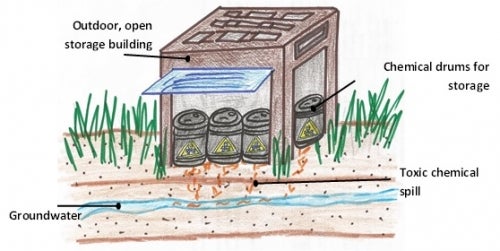If you would like to see more information on this case study, click here!
You can request this case study and a WCDE staff member will get back to you.
In 1989, Bata Industries, a wholly-owned subsidiary of the Bata Shoe Company, was a global shoe-manufacturing company comprising approximately 80 subsidiaries headed by CEO Thomas Bata. One of Bata Industries’ plants was located in Batawa, Ontario and produced leather footwear on a worldwide scale [1]. The manufacturing process for these products created hazardous liquid chemical waste such as volatile solvents [2]. These chemicals were stored in drums in an open, above-ground storage facility, as illustrated in Figure 1. There was a need to improve the storage facility in light of new regulations that were put into place in the 1980’s that indicated new procedures for properly storing and disposing chemicals.
On August 1, 1989, two officials from the Ontario Ministry of the Environment (MOE) visited the Batawa Plant on a routine checkup. They discovered that the relatively new environmental standards were not being met since Batawa’s storage drums were rusted, uncovered and seeping waste into the environment [3]. Later analysis showed that the toxic chemicals had polluted the groundwater [4]. The MOE had to decide what action it should take.

Figure 1 - Sketch of an example above ground, open chemical storage facility
The main teaching objective of this case study is to demonstrate liability and due diligence with a focus on reasonable care. Students will be placed in situations in the work force and they need to be aware of their role and responsibilities so that they continually act with reasonable care. By the end of the case study, students will be able to:
If you would like to see more information on this case study, click here!
You can request this case study and a WCDE staff member will get back to you.
Contact Waterloo Cases in Design Engineering
Steve Lambert
Tel: (519) 888-4728
Email: steve@uwaterloo.ca
The University of Waterloo acknowledges that much of our work takes place on the traditional territory of the Neutral, Anishinaabeg, and Haudenosaunee peoples. Our main campus is situated on the Haldimand Tract, the land granted to the Six Nations that includes six miles on each side of the Grand River. Our active work toward reconciliation takes place across our campuses through research, learning, teaching, and community building, and is co-ordinated within the Office of Indigenous Relations.